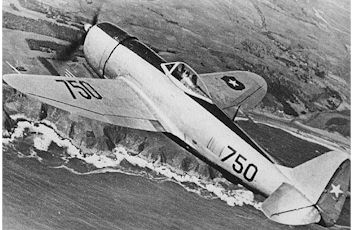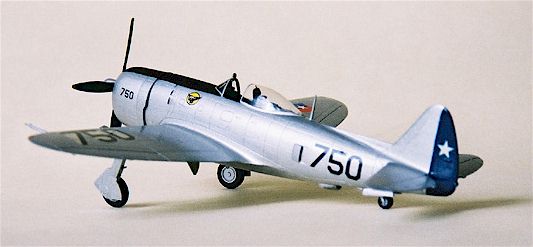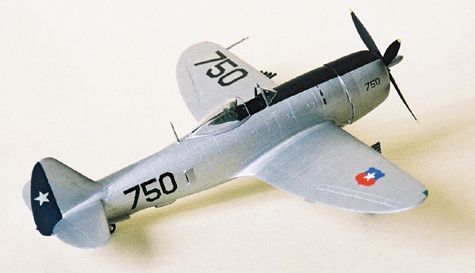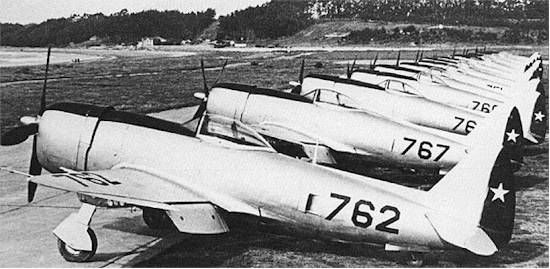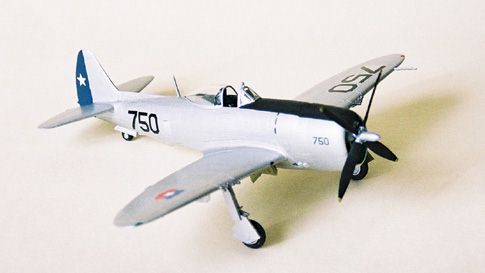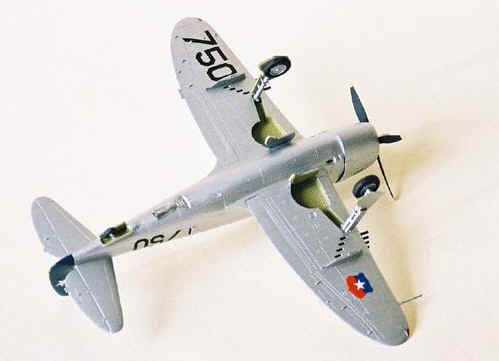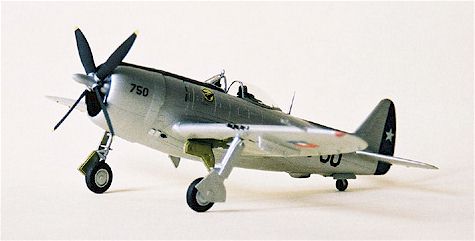The P-47 Thunderbolt of the Fuerza Aerea de Chile (FACH)
by Peter Ibes, IPMS Netherlands
The end of war and the advent of the jet fighter did not mean the end of the career of one of the most famous American fighters of World War 2, the P-47 Thunderbolt. Not only was it used on a large scale by the National Air Guard, the aircraft was also supplied to friendly nations. One of those countries was Chile that used the Jug until 1959.
The post-war surplus of Allied combat aircraft gave many small Latin American air forces an opportunity to strengthen their fighting ability at relatively low cost. This was made even easier by the US ARP (American Republics Project) programme, with which the US Government tried to secure its political influence in the region.
Chile was one of the countries that chose to participate in the project and on 1st July 1946 the Chilean airforce received it’s first six P-47Ds. Another six aircraft arrived in Chile on 13th November 1947.
At first instance all P-47s were delivered to the Grupo de Aviación No 2, on the airfield of Quintero, near the harbour town Valparaíso. At that time the Grupo was a multifunctional unit which also operated types like the Catalina, the Kingfisher and the B-25 Mitchell. On April 1st,1949 all P-47s were assigned in a separate fighter unit, the Grupo de Aviación No 5, also stationed at Quintero. A short time later a special P-47 unit was founded, the Grupo de Aviación No 11.
In 1952 only seven of the original twelve aircraft were still airworthy. Chile therefore received an additional shipment of 17 F-47s under the Mutual Defence Assistance Program (after the US Air Force became independent from the US Army the designation of fighter aircraft changed from P for Pursuit to F for Fighter). The delivery of these extra aircraft commenced in July 1953.
As a result, in June 1954 the Grupo de Aviación No 11 had reported 21 operational P/F-47s. In June 1957 some thirteen aircraft were still flying. These were decommissioned on 31 December 1958. Today only one P-47 is preserved in Chile, in the Museo Aeronáutico, in Santiago de Chile.
Camouflage and markings
All P-47s supplied to Chile were delivered in natural metal finish. The first batch had an Olive Drab anti-glare panel that extended over the entire upper fuselage. On the aircraft of the second batch the anti-glare panel was black and only applied to the fuselage in front of the cockpit.
The markings consisted of a white star on a bright blue rudder and Chilean roundels on the upper port wing and the lower starboard wing. Serial numbers were painted in black on both sides of the rear fuselage, the upper port and the lower starboard wing. In addition they were repeated in smaller numbers on the cowling and the wing leading edge.
The badge of the Grupo de Aviación No 11 was added to the port side of the fuselage below the cockpit.
The order of the serial numbers ion the Chilean P/F-47s is somewhat confusing, as it was customary within the FACH to re-use the numbers of crashed aircraft. Furthermore, some serial numbers 763, 764, 768 and 769 were never used.
P-47 Serial Numbers
| FACH serial no. | Sub type | USAF
serial no. |
Delivery Date | |
| 750 (1) | P-47D-35-RA | 44-90193 | 29/9/47 | Ex USAF Caribbean Air Command. Probably crashed. |
| 750 (2) | TF-47D-30-RA | 44-49219 | 18/7/53 | Converted to P-47 D-40. Decommissioned on 21/4/59, now in the museum in Santiago. |
| 751 (1) | P-47D-40-RA | 44-90336 | 29/9/47 | Crashed. |
| 751 (2) | F-47D-30-RA | 44-49221 | 18/7/53 | Converted to P-47 D-40. |
| 752 | F-47D-30-RA | 44-49337 | 29/9/47 | Decommissioned on 21/4/59 |
| 753 | F-47D-30-RA | 45-49343 | 29/9/47 | |
| 754 | F-47D-30-RA | 45-49353 | 29/9/47 | |
| 755 | F-47D-30-RA | 44-49391 | 29/9/47 | |
| 756 (1) | F-47D-30-RA | 44-34099 | 13/11/47 | Crashed on Quintero on 12/3/49 |
| 756 (2) | TF-47D-30-RA | 45-49250 | 18/7/53 | Converted to P-47 D-40. |
| 757 | F-47D-30-RA | 45-49442 | 13/11/47 | Decommissioned on 21/4/59 |
| 758 | F-47D-30-RA | 45-49471 | 13/11/47 | |
| 759 | F-47D-30-RA | 45-49481 | 13/11/47 | Decommissioned on 9/6/58 |
| 760 | F-47D-30-RA | 45-49509 | 13/11/47 | |
| 761 | F-47D-30-RA | 45-49229 | 13/11/47 | Crashed on Quintero on 8/6/49 |
| 762 | F-47D-30-RA | 45-49304 | 18/7/53 | Converted to P-47 D-40.
Decommissioned on 21/4/59. |
| 765 | F-47D-30-RA | 44-49345 | 18/7/53 | Converted to P-47 D-40.
Decommissioned on 21/4/59. |
| 766 | F-47D-30-RA | 45-49379 | 18/7/53 | Converted to P-47 D-40. |
| 767 | F-47D-30-RA | 45-49356 | 18/7/53 | Converted to P-47 D-40.
Decommissioned on 21/4/59. |
| 770 | F-47D-30-RA | 45-49506 | 18/7/53 | Converted to P-47 D-40.
Decommissioned on 21/4/59. |
| 771 | F-47D-30-RA | 45-49529 | 18/7/53 | Decommissioned on 21/4/59. |
| 772 | F-47D-30-RA | 45-49552 | 18/7/53 | Converted to P-47 D-40.
Decommissioned on 21/4/59. |
Source: Eduardo Ahumada
The Model
To build the Chilean Jug I used the Academy 1/72 P-47 D kit. Apart from some minor mistakes, such as the pitot tube on the wrong wing, this kit can be used to build into a very nice model. For the amount of detail included the kit is also very reasonably priced.
The kit features fine engraved panel lines and other surface detail. It further contains a lot of optional parts, such as a choice of two propellers (a pointed Curtiss Electric and a Hamilton Standard paddle-blade version), rocket launch tubes and a centerline drop tank.
Adjustments to model were, apart from putting the pitot tube on the correct wing, the addition of magnetos to the engines and an extra tail fillet from plasticard. The Chilean P-47s had wheels without hub covers. The kit only includes the covered-hub version, but I decided not to replace them.
Painting and finishing
My model depicts the Jug that is on display at the Museo Aeronáutico in Santiago de Chile. This is a P-47 D-40, with the Chilean serial number 750.
The model is painted with three thin layers of Humbrol Aluminium, with a finishing coat of clear satin varnish. The rudder has been painted Humbrol no. 15 Midnight Blue. The anti-glare panel was painted Humbrol np. 33 Matt Black. The Chilean roundels, the white star on the tail and the badge of the Grupo de Aviación No 11 came from a decal sheet from the Chilean IPMS. Serial numbers came from the Aeromaster sheet no. 72-011 US 45 degree ID Numbers and Letters Black.
This article was originally published in IPMS Stockholm Magazine in May 2001.
